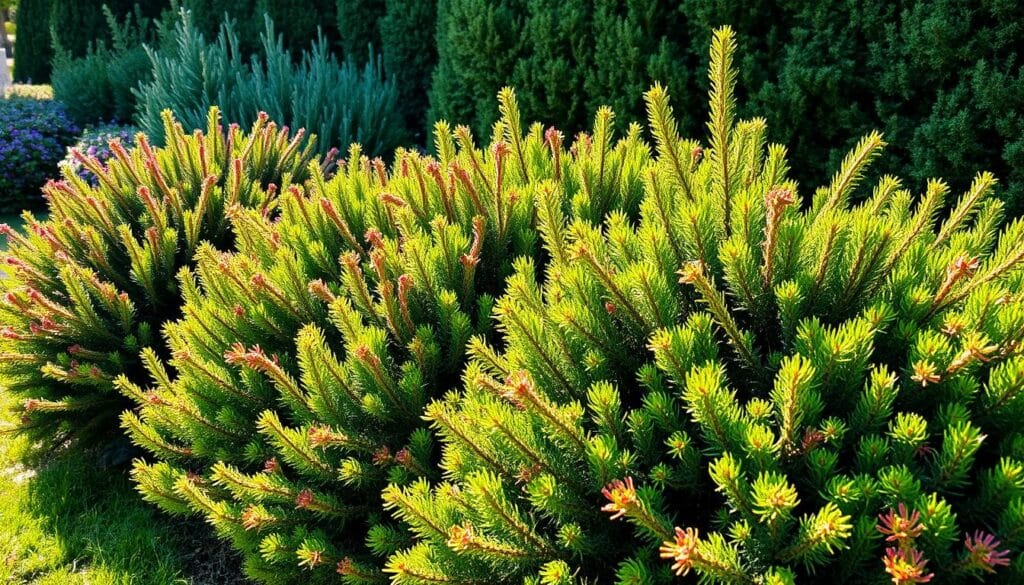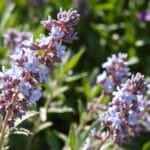Did you know junipers can grow up to 50 feet tall? Many think of them as small shrubs1. This shows how diverse the Juniperus genus is, with many evergreen shrubs and trees. Exploring junipers, I’m always amazed by their flexibility and ability to adapt.
Junipers come in many shapes and sizes for gardens and landscapes. They range from low-growing ground covers to midsize shrubs with unique shapes1. Their blue-green leaves add beauty all year, making them popular in U.S. gardens2.
Junipers stand out for their toughness and ability to handle harsh weather. These evergreen shrubs are great for areas with unpredictable weather2. They grow moderately and do well in USDA zones 4-9, fitting many climates3.
Adding junipers to landscapes makes them more beautiful and durable. Their scent and ability to handle tough conditions make gardens last longer. This adds to the garden’s appeal and longevity.
Key Takeaways
- Junipers range from ground covers to 50-foot trees
- Distinctive blue-green foliage offers year-round interest
- Known for hardiness and wind resistance
- Thrive in USDA growing zones 4-9
- Versatile for various landscaping needs
- Contribute to resilient and stunning landscapes
- Aromatic foliage enhances sensory garden experience
Introduction to Juniper (Juniperus spp.)
Junipers are evergreen shrubs that belong to the Cypress family (Cupressaceae). They are found in the Northern Hemisphere, from the Arctic to tropical Africa, parts of Asia, and Central America4. They can grow in many climates, from sea level to high altitudes.
The Juniperus genus has 50 to 67 species, each unique4. Some junipers are tall trees, while others are low-spreading shrubs. This variety makes them great for different landscaping needs.
Junipers are important in their ecosystems. They feed wildlife, help control erosion, and boost biodiversity. In places like southeastern Tibet and the northern Himalayas, they even form high tree lines at up to 4,900 meters4.
Junipers are adaptable and resilient. They grow well in zones 7 through 10, blooming and pollenating many times a year4. Their leaves can be needle-like or scale-like, making them beautiful in gardens. They are perfect for both new and experienced gardeners who want easy-to-care-for plants.
“Junipers are nature’s hardy survivors, adapting to diverse landscapes and climates with remarkable resilience.”
In the next sections, we’ll dive into the world of juniper species. We’ll look at their roles in landscaping and how to care for them in your garden.
The Diverse World of Juniper Species
The juniper family is vast and varied, with 66 species in the Juniperus genus5. I find the diversity of juniper species and their habitats fascinating. These evergreens have adapted to many environments, showing nature’s strength.
Common Juniper Varieties
Juniper species vary from ground covers to tall trees. Some well-known types include:
- Ground covers: Blue Rug, Blue Pacific
- Shrubs: Blue Star, Gold Coast
- Trees: Blue Point, Eastern Red Cedar
Unique Characteristics of Different Juniper Types
Each juniper type has its own features. Their foliage colors range from silvery-blue to deep green. Textures vary from soft to prickly. Growth habits also differ, with some spreading low and others growing tall.
Native Habitats and Distribution
Juniper species are found across Asia, Europe, North and South America, and Africa6. They thrive in many environments, from coastlines to mountains. This adaptability has led to interesting evolutionary patterns.
Scientists believe that ancient Juniperus species lived in warm climates similar to the Madrean-Tethyan Flora belt during the Eocene era5. The Pliocene period saw a rapid growth of semiarid regions, juniper’s main habitat. J. communis expanded its range in the past 2 million years5.
| Time Period | Event |
|---|---|
| 50-72 million years ago | Juniperus diverged from Cupressus |
| 30-43 million years ago | First disjunction between Eurasian and North American species |
| 5-17 million years ago | Second disjunction between Eurasian and North American species |
| 0.3-4.6 million years ago | Third disjunction between Eurasian and North American species |
| Past 2 million years | Rapid expansion of J. communis distribution |
This rich history and global spread have made juniper species important to many cultures. They’ve been used for purification rituals for thousands of years. They are also valued for their medicinal properties, including antiseptic, antioxidant, and anti-inflammatory effects6.
Juniper’s Role in Landscaping
Junipers are amazing evergreen shrubs for gardens. They are great for many uses like groundcovers, privacy screens, and more. They add color and texture all year round.
Junipers are perfect for different landscaping needs. They’re good for places hard to mow and stop soil erosion. They also do well in rock gardens and when planted in large groups. With over 50 species and hundreds of varieties, there’s always something new for gardeners7.
When designing your garden, think about the size and growth of juniper types. For example, ‘Parsonii’ grows up to 2-1/2 feet tall. But ‘Blue Pacific’ and ‘Dwarf Shore’ stay about a foot tall8. This variety lets you get creative with your garden design.
“Junipers are the chameleons of the garden world, adapting to almost any landscaping role you can imagine.”
Junipers are also easy to care for. They do well in dry areas and full sun, which is great for those who don’t have a lot of time to garden7. They’re also deer-resistant, which is a big plus for many homeowners8.
| Juniper Variety | Height | Spacing |
|---|---|---|
| Parsonii | 2-1/2 feet | 3 feet apart |
| Blue Pacific | 1 foot | 2-1/2 feet apart |
| Dwarf Shore | 1 foot | 2-1/2 feet apart |
Even though junipers are tough, they can still face problems. Spider mites, scale insects, and bagworms can harm them. Fungal diseases and root rot in wet soil are also risks7. But with regular checks and proper care, your juniper garden can stay healthy and look great.
Selecting the Right Juniper for Your Garden
Choosing the perfect juniper for your garden is important. It ensures the plant thrives. I’ll help you understand what to look for when picking these plants for your landscape.
Climate Considerations
Junipers can grow in many climates. Zone 9, for example, has many juniper types. You can find everything from small groundcovers to tall trees for your garden design9.
In Zone 9, you can find short junipers like Bar Harbor and Grey Owl. There are also taller ones, like the California juniper, which can grow up to 15 feet tall9.
Soil Requirements
Junipers are easy to care for when it comes to soil. They like well-draining soil but can adjust to different types. Make sure your soil drains well to avoid root rot.
These plants do well in rocky or sandy soils. This makes them perfect for tough garden spots.
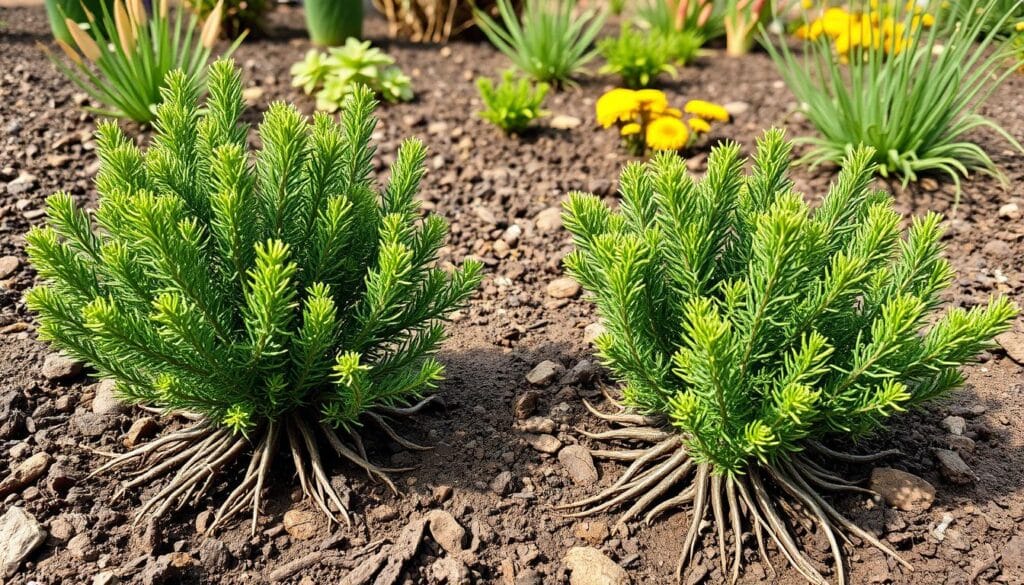
Space and Size Factors
Think about how big your juniper will get. Ground cover junipers like Blue Rug can grow fast, up to 12 inches a year. Shrubs grow slower, 4 to 8 inches a year10.
For bigger areas, tree junipers like Blue Point grow about 1 foot a year. They can reach up to 12 feet tall and 6 to 8 feet wide10.
Sunlight Needs
Most junipers love full sun but can handle partial shade. Sunlight affects their growth and color. For example, the Gold Coast Juniper shows off its golden-yellow foliage all year in sunny spots10.
| Juniper Type | Growth Rate | Mature Size | Ideal Zones |
|---|---|---|---|
| Blue Rug | Up to 12 inches/year | Groundcover | 4-9 |
| Blue Point | 1 foot/year | 12 feet tall, 6-8 feet wide | 4-9 |
| Grey Owl | 4-8 inches/year | 3-5 feet tall, 6 feet wide | 3-9 |
By thinking about these factors, you can pick the right juniper. It will fit your garden’s needs and make it look great.
Planting Junipers: Best Practices
Planting junipers is best in spring or fall. These evergreens grow well in USDA Hardiness Zones 3 to 9. This makes them perfect for many climates1112. When picking a spot, choose one with full sun to partial shade. Junipers love sunlight12.
To begin, dig a hole twice as wide as the root ball and the same depth. This lets the roots spread out. Place the juniper in the hole, making sure the root ball is a bit above the soil. This helps with drainage and keeps water away from the stem.
After placing the plant, fill the hole with the soil you removed. Gently press down to remove air pockets. Watering deeply is key at this point. Junipers can handle drought once they’re established, but they need regular water in the first year for root growth12.
To complete the process, add a layer of mulch around the plant. This keeps moisture in and stops weeds. Plus, junipers are great for controlling erosion on slopes and hillsides12. With these steps and proper care, your juniper will flourish and beautify your garden for years.
“Planting junipers is like setting the foundation for a living sculpture in your garden. With the right care, they’ll grow into stunning, low-maintenance focal points.”
Juniper Care and Maintenance
Juniper care is key to keeping these evergreens thriving in your garden. I’ll share important tips on watering, fertilizing, and pest control.
Watering Requirements
Junipers can handle dry spells but need deep watering. For potted junipers, water weekly or when the soil feels dry13. This keeps them hydrated without harming the roots.
Fertilization Tips
Junipers don’t need much food but a yearly fertilizer boost is good. I fertilize in late winter to early spring14. Container-grown junipers get a spring fertilizer for growth13.
Pruning Techniques
Pruning junipers is simple but important. I remove dead or sick branches to keep them healthy. I prune in late winter for shaping14. This helps them grow strong in spring.
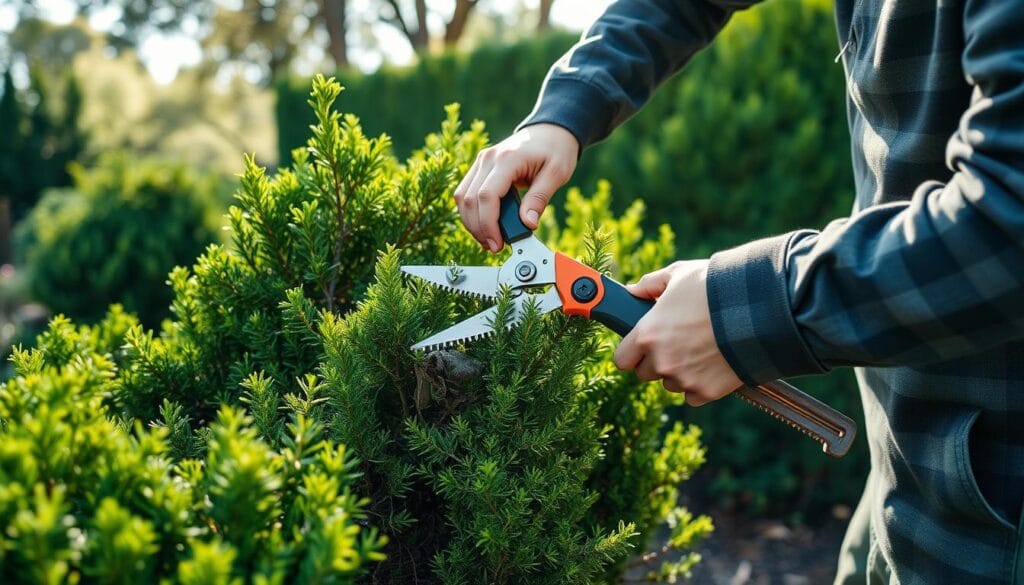
Pest and Disease Management
Keep an eye out for pests and diseases. I check my junipers often and treat problems quickly. Common issues include spider mites and twig blight. Early detection helps manage them with organic solutions or treatments.
Junipers love full sun and well-drained soil. They do well in many soil types and pH levels14. Follow these care tips to keep your junipers healthy and beautiful.
Juniper as Ground Cover
Juniper is a great choice for ground cover in many landscapes. With over 170 species, there’s a juniper for every garden15. Low-growing types like creeping juniper and shore juniper are perfect for stopping erosion on slopes.
Creeping juniper spreads up to 5-6 feet but stays low, about 2 feet tall15. It’s great for covering big areas fast. Shore juniper grows 12-18 inches tall and spreads 6-8 feet, perfect for coastal areas because it tolerates salt15.
Juniper does well in poor soils and compacted areas, making it perfect for tough urban spots16. Plant them 3-6 feet apart on slopes and 1-4 feet apart in flat areas for the best coverage.
| Juniper Type | Height | Spread | Best Use |
|---|---|---|---|
| Creeping Juniper | Up to 2 feet | 5-6 feet | Slopes, banks |
| Shore Juniper | 12-18 inches | 6-8 feet | Coastal areas |
| Japanese Garden Juniper | 2 feet | 12-20 feet | Wide spaces |
Types like ‘Blue Rug’ and ‘Blue Pacific’ have stunning silvery-blue leaves that turn bronze in winter16. They’re perfect for rock gardens and cascading over walls, creating a beautiful, easy-to-care-for ground cover that keeps weeds away and holds the soil in place.
Juniper Shrubs for Ornamental Purposes
Ornamental junipers are a key part of landscape design, bringing beauty all year. They grow well in many conditions, fitting into different garden styles17.
Popular Ornamental Juniper Varieties
Blue Star, Gold Coast, and Grey Owl junipers are great for adding texture and color. They have unique leaves and grow in interesting ways.
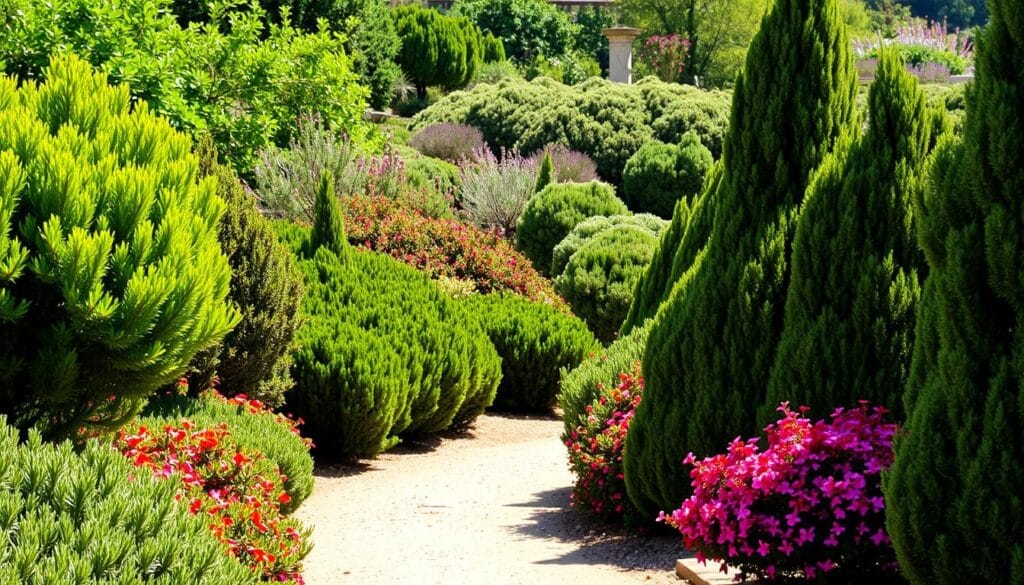
Juniperus communis, a common type, can grow up to 9 meters tall and 4 meters wide. It’s adaptable, doing well in sandy, loamy, and clay soils18.
Design Ideas for Juniper Shrubs
In my designs, I use junipers in many ways:
- Mixed borders: Pair junipers with flowers for contrast
- Foundation plantings: Use low-growing types to soften building lines
- Standalone specimens: Highlight unique juniper shapes as focal points
- Topiaries: Shape junipers into fun shapes
Junipers grow slowly, adding just a few centimeters each year. This makes them perfect for long-term plans18.
| Juniper Variety | Height | Spread | Foliage Color |
|---|---|---|---|
| Blue Star | 1-3 feet | 2-3 feet | Blue-silver |
| Gold Coast | 2-3 feet | 4-5 feet | Golden-yellow |
| Grey Owl | 3-5 feet | 4-6 feet | Silver-gray |
Junipers are dioecious, meaning each shrub is either male or female. This adds interest and helps local ecosystems18.
Juniper Trees: Towering Evergreens
Juniper trees are tall and beautiful, making them great for both looks and function. They have scale-like leaves and are very hardy. This makes them a top pick for landscapers and homeowners19. They’re especially good for making privacy screens and blocking wind.
Columnar junipers like the Spiny Greek Juniper and Green Columnar Juniper are great for tall, narrow spots. They can grow up to 20 feet tall but stay slim. This is perfect for small areas or as tall guards by doors.
Juniper trees are also loved for their green leaves all year. They don’t lose their leaves like some trees do, keeping your space private and calm20. Homeowners really like this because it means their privacy stays strong all the time.
But juniper trees are more than just pretty. They’re also very practical. They can handle drought, need little care, and fight off pests and diseases20. This makes them great for many landscaping jobs, especially where other plants might not do well.
When picking juniper trees for your yard, think about how fast they grow and how big they’ll get. While they can take 400 years to grow fully in nature, garden varieties grow faster21. With the right care, like enough water, mulch, and occasional trimming, your juniper trees will be beautiful and useful for years19.
The Many Uses of Juniper
Juniper is more than just a pretty evergreen shrub. It has many uses, from cooking to medicine and even in aromatherapy. Let’s dive into its culinary, medicinal, and essential oil benefits.
Culinary Applications
Juniper berries add a unique flavor to food. They’re key in making gin, giving it a special taste. These berries also make game meats, sauerkraut, and desserts taste better with their piney and citrusy notes.
| Culinary Use | Description |
|---|---|
| Gin Flavoring | Primary flavoring agent in gin production |
| Meat Seasoning | Enhances game meats and pork dishes |
| Vegetable Complement | Pairs well with sauerkraut and root vegetables |
| Dessert Accent | Adds complexity to fruit-based desserts |
Medicinal Properties
Juniper has been used for medicine for a long time. It’s full of compounds like aromatic oils and resins22. These help with health, like being a diuretic and treating stomach issues22.
Essential Oils and Aromatherapy
Juniper essential oils are great for cleaning and purifying. They come from the berries and have terpenoids22. Research shows they’re good for fighting bacteria and inflammation22.

Juniper berry oil can also keep meat fresh longer22. This shows how versatile juniper is, from food to medicine and even in aromatherapy23.
Juniper and Wildlife: Creating Habitats
Junipers are key in making homes for wildlife, offering both shelter and food. They help make our native landscapes more diverse. For example, the Western juniper has grown a lot since the 1870s. Now, it covers about 8 million acres in the Northwest, helping many animals24.
The thick leaves of junipers are perfect for birds to nest in. Trees that are over 300 years old have special cavities for birds and some mammals24. In Texas, Ashe juniper and redberry juniper cover huge areas, making lots of space for wildlife25.
Juniper berries are full of energy, with 46% carbs and 16% fat. They are a favorite snack for birds, rabbits, coyotes, and small mammals24. One Ashe juniper tree can make 100,000 to 250,000 berries, feeding many animals25.
Many bird species live in juniper areas, especially in winter when berries are easy to find. Small mammals, like rodents, also eat these berries. Their numbers go up when junipers are thinned out, along with other plants24.
Learning about junipers’ role in wildlife habitats helps us value and care for these plants. This way, we can help our local ecosystems thrive.
Juniper in Bonsai Art
I’ve always been fascinated by bonsai art, and junipers are a highlight. These evergreens are great for creating beautiful bonsai pieces.
Popular Juniper Species for Bonsai
The Juniperus genus has 50-70 species, offering many choices for bonsai lovers26. Some top picks include:
- Common Juniper (Juniperus communis): Great for windy spots26.
- Chinese Juniper (Juniperus chinensis): Known for its unique shape as it grows26.
- California Juniper (Juniperus californica): Drought-resistant and often grown as a shrub26.
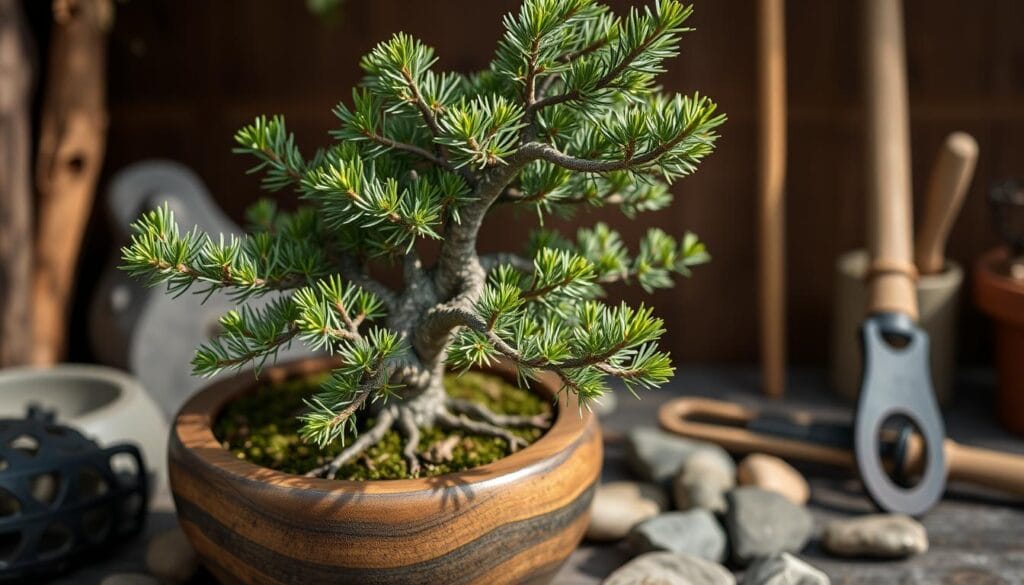
Bonsai Techniques for Junipers
Juniper bonsai care involves specific techniques for their health and beauty. Proper pruning is key for their look and health26. Regular shaping helps achieve the desired tree form.
Junipers thrive outdoors. They need lots of sunlight and can handle cold temperatures down to 10 degrees Fahrenheit26. This makes them perfect for outdoor growth all year.
With proper care, juniper bonsai can live over 100 years, becoming living works of art26.
Repotting is vital for juniper bonsai care. Young trees need repotting every two years, while older ones can go up to five years26. This ensures their roots stay healthy and they get the nutrients they need.
For those wanting to grow their collection, junipers can be propagated through cuttings. The best time for this is late spring and summer26. It’s a rewarding way to create new bonsai from existing ones.
| Juniper Bonsai Care Aspect | Recommendation |
|---|---|
| Sunlight | Bright, direct sunlight |
| Temperature Tolerance | Down to 10°F without protection |
| Repotting Frequency (Young Trees) | Every 2 years |
| Repotting Frequency (Older Trees) | Up to 5 years |
| Propagation Method | Cuttings in late spring/summer |
While juniper bonsai are generally hardy, they can face challenges from pests like spruce spider mites and fungal diseases such as blight and rust26. Regular checks and proper care help prevent these problems, keeping your bonsai healthy and beautiful for years.
Troubleshooting Common Juniper Issues
Working with junipers, I’ve seen many challenges. Keeping them pest-free and well-cared for is key. Let’s look at some common problems and how to fix them.
Watering is a big issue with junipers. Too much water can cause yellow stems and soft roots. Not enough water makes leaves dry and brown27. I check the soil before watering and make sure it drains well to avoid root rot.
Light is also important for junipers. Too little light makes them grow too tall and sparse. Too much light can burn their leaves27. Finding the right amount of sunlight is crucial for their health.
Pest and Disease Management
Junipers face many pests and diseases. Aphids, spider mites, and scale insects are common2728. Regular checks help me spot these early. I watch for powdery mildew, rust, and black rot2728.
“Early detection of issues leads to better outcomes in juniper care.”
To keep them healthy, I fertilize in the growing season and water regularly2728. This helps avoid many problems and keeps my junipers thriving.
| Issue | Symptoms | Solution |
|---|---|---|
| Overwatering | Yellow stems, squishy roots, wilting | Reduce watering, improve drainage |
| Underwatering | Dry foliage, brown tips, stunted growth | Increase watering frequency |
| Pest infestation | Visible insects, leaf damage | Apply appropriate pesticides |
| Diseases | White spots, distorted leaves, rot | Treat with fungicides, improve air circulation |
Conclusion
Exploring juniper (Juniperus spp.) has shown me their amazing versatility and strength. They can grow from small groundcovers to tall trees, adding beauty all year. Their ability to grow well in many places is impressive, as seen in studies on their spread and effect on plants below them29.
Junipers are not just pretty; they also help wildlife and can feed animals like goats and sheep29. This makes them a great choice for gardeners wanting to create diverse and strong landscapes.
However, junipers can also have a big impact on nature. They can crowd out other plants and affect how well animals can graze30. Their leaves can also stop other plants from growing, showing we need to manage them carefully in the wild30. When we add junipers to our gardens, let’s enjoy their beauty and usefulness while thinking about how they affect the environment.
FAQ
What are some common juniper varieties?
What climates do junipers thrive in?
How much sunlight do junipers need?
What are the soil requirements for junipers?
How should I water my juniper plants?
What are some pruning tips for junipers?
How can I use junipers as ground cover?
What are the benefits of using juniper shrubs for ornamental purposes?
How tall can juniper trees grow?
What are some culinary uses of juniper?
Do junipers provide habitat for wildlife?
Are junipers suitable for bonsai?
What are some common issues with junipers?
Source Links
- propagating spreading juniper – Ask Extension
- Wind Tolerant Plants — Gardenette | Garden designs for DIYers in WNY
- Green Columnar Juniper
- Juniper
- Juniperus (juniper) description
- Viriditas: Musings on Magical Plants: Juniperus spp.
- Landscaping with Junipers
- Junipers
- Types Of Juniper – A Guide To Growing Juniper In Zone 9
- Junipers | Evergreen Shrubs | PlantingTree.com – PlantingTree
- How to Plant and Grow Juniper Shrubs | Gardener’s Path
- Juniper plants: Tips to grow and care
- How To Grow A Potted Juniper: Caring For Juniper Trees In Containers
- Common Juniper: Plant Care & Growing Guide
- Juniper Groundcovers
- ENH1306/EP570: Key Plant, Key Pests: Juniper (Juniperus spp.)
- juniperus communis Juniper, Common juniper PFAF Plant Database
- Exploring Types of Evergreens
- Unveiling the Beauty and Utility of Evergreen Trees for Privacy
- A Guide to Conifers: 22 Popular Types – Garden Design
- Potential of Juniperus communis L as a nutraceutical in human and veterinary medicine
- JUNIPER: Overview, Uses, Side Effects, Precautions, Interactions, Dosing and Reviews
- juniper3
- Juniper ecology
- How to Grow and Care for Juniper Bonsai
- 💡 Ultimate Guide to Solving Juniper Tree Problems
- Ultimate Guide to Solving Juniper Problems
- Genetic background of juniper (Juniperus spp.) consumption predicted by fecal near-infrared spectroscopy in divergently selected goats raised in harsh rangeland environments
- THE EFFECTS OF JUNIPER LITTER DEPTH AND ALLELOPATHY ON TWO NATIVE SPECIES
